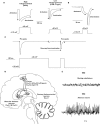Low threshold T-type calcium channels as targets for novel epilepsy treatments
- PMID: 23834404
- PMCID: PMC4004393
- DOI: 10.1111/bcp.12205
Low threshold T-type calcium channels as targets for novel epilepsy treatments
Abstract
Low voltage-activated T-type calcium channels were originally cloned in the 1990s and much research has since focused on identifying the physiological roles of these channels in health and disease states. T-type calcium channels are expressed widely throughout the brain and peripheral tissues, and thus have been proposed as therapeutic targets for a variety of diseases such as epilepsy, insomnia, pain, cancer and hypertension. This review discusses the literature concerning the role of T-type calcium channels in physiological and pathological processes related to epilepsy. T-type calcium channels have been implicated in pathology of both the genetic and acquired epilepsies and several anti-epileptic drugs (AEDs) in clinical use are known to suppress seizures via inhibition of T-type calcium channels. Despite the fact that more than 15 new AEDs have become clinically available over the past 20 years at least 30% of epilepsy patients still fail to achieve seizure control, and many patients experience unwanted side effects. Furthermore there are no treatments that prevent the development of epilepsy or mitigate the epileptic state once established. Therefore there is an urgent need for the development of new AEDs that are effective in patients with drug resistant epilepsy, are anti-epileptogenic and are better tolerated. We also review the mechanisms of action of the current AEDs with known effects on T-type calcium channels and discuss novel compounds that are being investigated as new treatments for epilepsy.
Keywords: T-type calcium channels; anti-epileptic drugs; epilepsy.
© 2013 The British Pharmacological Society.
Figures

Similar articles
-
Towards the discovery of novel T-type calcium channel blockers.Expert Opin Ther Targets. 2007 May;11(5):717-22. doi: 10.1517/14728222.11.5.717. Expert Opin Ther Targets. 2007. PMID: 17465728 Review.
-
The role of T-type calcium channels in epilepsy and pain.Curr Pharm Des. 2006;12(18):2189-97. doi: 10.2174/138161206777585184. Curr Pharm Des. 2006. PMID: 16787249 Review.
-
T-type Ca2+ channels as therapeutic targets in the nervous system.Curr Opin Pharmacol. 2008 Feb;8(1):33-41. doi: 10.1016/j.coph.2007.12.003. Epub 2008 Jan 18. Curr Opin Pharmacol. 2008. PMID: 18203662 Review.
-
Pharmacology of recombinant low-voltage activated calcium channels.Curr Drug Targets CNS Neurol Disord. 2004 Apr;3(2):105-11. doi: 10.2174/1568007043482543. Curr Drug Targets CNS Neurol Disord. 2004. PMID: 15078185 Review.
-
Ion channels and epilepsy.Curr Pharm Des. 2005;11(15):1975-2003. doi: 10.2174/1381612054021006. Curr Pharm Des. 2005. PMID: 15974971 Review.
Cited by
-
A Pharmacological Perspective on Plant-derived Bioactive Molecules for Epilepsy.Neurochem Res. 2021 Sep;46(9):2205-2225. doi: 10.1007/s11064-021-03376-0. Epub 2021 Jun 12. Neurochem Res. 2021. PMID: 34120291
-
T-Type Ca2+ Enhancer SAK3 Activates CaMKII and Proteasome Activities in Lewy Body Dementia Mice Model.Int J Mol Sci. 2021 Jun 8;22(12):6185. doi: 10.3390/ijms22126185. Int J Mol Sci. 2021. PMID: 34201181 Free PMC article.
-
Modulation of T-type Ca2+ channels by Lavender and Rosemary extracts.PLoS One. 2017 Oct 26;12(10):e0186864. doi: 10.1371/journal.pone.0186864. eCollection 2017. PLoS One. 2017. PMID: 29073181 Free PMC article.
-
Cellular resolution contributions to ictal population signals.Epilepsia. 2024 Jul;65(7):2165-2178. doi: 10.1111/epi.17983. Epub 2024 May 16. Epilepsia. 2024. PMID: 38752861 Free PMC article.
-
Schiff Bases: A Captivating Scaffold with Potential Anticonvulsant Activity.Mini Rev Med Chem. 2024;24(18):1632-1650. doi: 10.2174/0113895575302197240408121537. Mini Rev Med Chem. 2024. PMID: 38629363 Review.
References
-
- Catterall WA, Perez-Reyes E, Snutch TP, Striessnig J. International Union of Pharmacology. XLVIII. Nomenclature and structure-function relationships of voltage-gated calcium channels. Pharmacol Rev. 2005;57:411–425. - PubMed
-
- Perez-Reyes E. Molecular physiology of low-voltage-activated t-type calcium channels. Physiol Rev. 2003;83:117–161. - PubMed
-
- Kozlov AS, McKenna F, Lee JH, Cribbs LL, Perez-Reyes E, Feltz A, Lambert RC. Distinct kinetics of cloned T-type Ca2 + channels lead to differential Ca2 + entry and frequency-dependence during mock action potentials. Eur J Neurosci. 1999;11:4149–4158. - PubMed
Publication types
MeSH terms
Substances
Grants and funding
LinkOut - more resources
Full Text Sources
Other Literature Sources
Medical
Molecular Biology Databases
Miscellaneous

